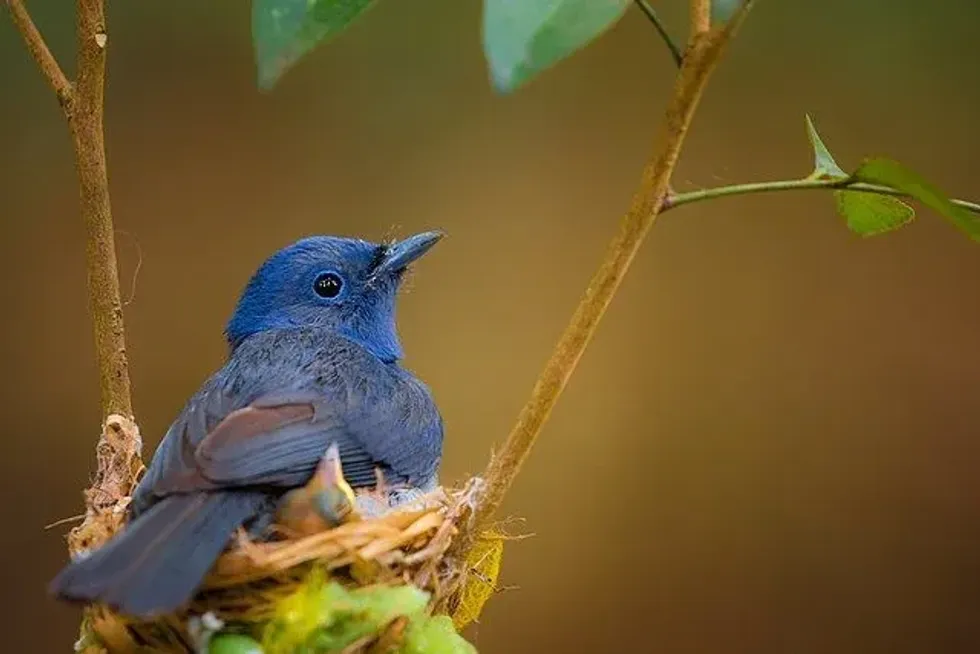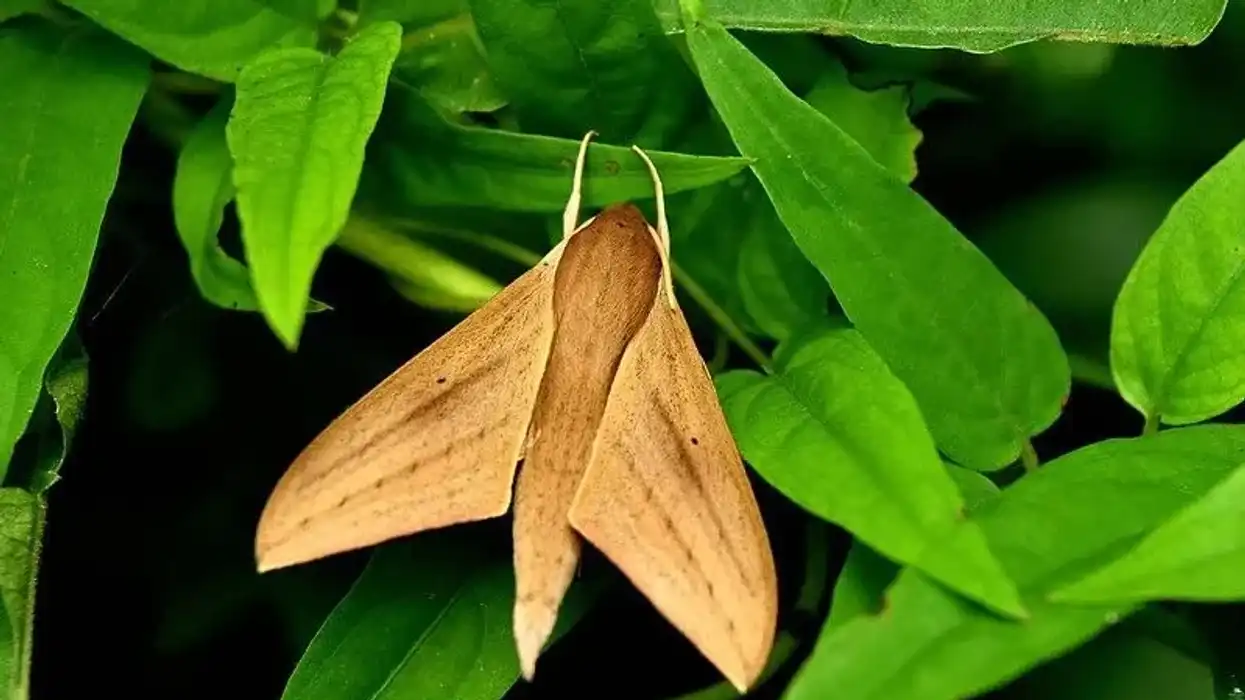If you like learning about different types of birds, then you will love reading about the beautiful black-naped monarch bird. The black-naped monarch (Hypothymis azurea), which is also known as the black-naped flycatcher, lives in countries in south Asia.
It prefers living in tropical forested areas but can also be found in areas with sufficient wood habitats. It is a beautiful bird that is pale blue with black markings.
These monarch flycatchers got their name due to the presence of their black nape. Even though male monarch flycatchers and female monarch flycatchers have a difference in their appearance, both look extremely attractive. Their grayish-brown wings and the patch on the back of their heads make them stand out.
To add to this, black-naped blue monarch flycatchers are pretty social birds. These mainly pale blue birds show monogamous behavior.
After mating, around two to three eggs are laid in a nest made by females. The males take care of guarding the nest.
To know more about this bird, keep on reading. For more relatable content, check out these American bittern facts and blue jay facts for kids.
Black-Naped Monarch Interesting Facts
What type of animal is a black-naped monarch?
The black-naped monarch (Hypothymis azurea) is a type of bird. It belongs to the family Monarchidae and the order Passeriformes.
What class of animal does a black-naped monarch belong to?
The black-naped monarch (black-napped flycatcher) belongs to the Aves class of the Animalia kingdom. It is a member of the phylum Chordata and the genus Hypothymis. The scientific name of this flycatcher is Hypothymis azurea.
How many black-naped monarchs are there in the world?
The black-naped monarch is quite widespread in its distribution range. Flocks of the black-napped monarch in flight are a very common sight.
According to the International Union for Conservation of Nature (IUCN), the population of this bird has remained pretty stable over the years. However, the exact number of black-naped monarch or black-naped flycatcher birds living in this world is not known.
Where does a black-naped monarch live?
Black-naped monarch birds are native to Asia. This bird species lives in the thick forests of southern Asia. They are quite widespread in forests and well-wooded areas in Sri Lanka and India. Apart from that, Indonesia, Iran, and other Asian countries are also home to these blue birds.
What is a black-naped monarch's habitat?
The Hypothymis azurea species is found in forests. The habitats of this bird are mostly tree-dependent. So, forests and well-wooded areas of their distribution range are home to black-naped monarch populations.
Who do black-naped monarchs live with?
Unlike scissor-tailed flycatchers, this flycatcher is a social species of bird. They can be seen flying in large communal flocks and these flocks can sometimes include similar-sized birds from other species. Black-naped monarch birds also roost together. The young, immature chicks stay with their parents until they learn to fly and defend themselves.
How long does a black-naped monarch live?
The average life expectancy of these monarchs is just over four years.
How do they reproduce?
The breeding season varies from one range to another. For example, breeding in India starts from March to September and breeding occurs from March to June until September in the Philippines.
The nesting period is generally 10 days long and the female does most of the work while nesting. Females build a small cup nest and these birds even put cobwebs and spider egg cases inside the cup nest.
Males, on the other hand, are in charge of guarding the nest. Hypothymis azurea birds are a monogamous species.
Generally, two to three eggs are laid in the nest and the incubation period goes on for about 14 days. Male and female birds both take an active part in the incubation process and the young, immature chicks stay under the care of their parents till they are capable of defending themselves.
What is their conservation status?
The International Union for Conservation of Nature or the IUCN has listed Hypothymis azurea as a species of Least Concern in their Red List of Threatened Species. Moreover, their population trend is known to be stable.
Black-Naped Monarch Fun Facts
What do black-naped monarchs look like?
The Hypothymis azurea is an azure-blue bird found in tropical forest habitats. Males and females have noticeable differences in their appearance. The male black-naped monarch or black-naped flycatcher has a plumage that is generally pale blue.
However, males also have white underparts. Females, on the other hand, have a duller color.
The male black-naped monarch also has a black nape and a black gorget that is absent in females. Female birds have grayish-brown wings and blue-gray underparts. Both male and female birds have blue bills with black tips and apple-green-colored mouths.
How cute are they?
The black-naped monarch (Hypothymis azurea) is an extremely cute bird. They have a vibrant color that makes them look attractive.
How do they communicate?
The black-naped monarch (Hypothymis azurea) uses a call that is similar to that of many other flycatchers to communicate. The most common call used by them is a high-pitched continuous 'wii-wii'. It also uses other calls like 'shweb-shweb' and 'tit-tit-tit'.
How big is a black-naped monarch?
A black-naped monarch, also known as a black-naped flycatcher, has a body length of about 5.9-6.7 in (15-17 cm). When compared to another species of flycatcher, the vermilion flycatcher, this bird is slightly bigger. However, it is much shorter than the chestnut-headed bee-eater bird found in parts of Asia.
How fast can a black-naped monarch fly?
This black-naped blue flycatcher (Hypothymis azurea) is an active bird. It can fly quite fast and even has the ability to forage on the ground. The diet of this bird solely consists of insects, so they have to move fast to catch an insect in flight. However, the exact speed at which they fly is not known.
How much does a black-naped monarch weigh?
The black-naped monarch belonging to the order Passeriformes, family Monarchidae, and genus Hypothymis weighs 0.3-0.6 oz (8-17 g) on average. It weighs almost the same as the least flycatcher that weighs about 0.3-0.5 oz (8-13 g).
What are the male and female names of the species?
A male black-naped monarch is called a 'cock', whereas a female black-naped monarch is referred to as a 'hen'.
What would you call a baby black-naped monarch?
Babies of all birds are called chicks. So, babies of this species of bird will be referred to as the same.
What do they eat?
Black-naped monarchs are skilled flycatchers. Their diet mainly consists of various insects and they can sometimes be seen foraging on the ground. However, they mostly catch insects in flight. These flycatchers can be seen hovering in front of leaves to disturb insects.
Being able to move through branches actively comes to their advantage. These monarchs catch more prey by gleaning on leaves than snatching. The most consumed insects of these birds are grasshoppers, moths, and butterflies. They also prey on small beetles.
The black-naped monarch is mostly seen looking for food in large communal flocks. However, they can also be observed alone or in a pair looking for insects. It uses its legs to hold onto comparatively larger insects and then tears them into small parts.
Are they poisonous?
Even though the black-naped blue flycatcher (Hypothymis azurea) preys on a large number of insects, it is not known to be poisonous. They are social birds and they do not cause any harm to humans.
Would they make a good pet?
Hypothymis azurea birds belonging to the family Monarchidae and genus Hypothymis are attractive birds with social behavior. However, it is not advisable to keep the birds in captivity. The best way you can show love to them is by letting them stay in their natural habitat, which is well-wooded habitats and tropical forests.
Did you know...
The Hypothymis azurea species has many identified subspecies living in well-wooded habitats and forests. Each has distinguishing features and a set distribution range.
Among them, those living in Car Nicobar and the Lesser Sundas are quite famous. Males of the Sri Lankan subspecies (H. a. ceylonensis) have noticeable differences in appearance as these males of the Sri Lankan subspecies (H. a. ceylonensis) lack black markings.
Are black-naped monarchs endangered?
Spotting a flock of these monarchs in flight is a common event in their natural habitat. Their population has remained quite stable over the years.
Moreover, the species is listed as Least Concern in the International Union for Conservation of Nature (IUCN) Red List of Threatened Species. No recovery plans are in action for the black-naped monarch. So, it can be concluded that their population is not at any immediate risk and they are not endangered.
What does a black-naped monarch look like?
The black-naped blue monarch has a narrow black half collar and a distinctive black patch. These birds often hunt by flycatching so they are quite unique in this way. Their plumage is blue apart from black markings and they have a black nape and gorget that make them stand out.
Here at Kidadl, we have carefully created lots of interesting family-friendly animal facts for everyone to discover! Learn more about some other birds from our monk parakeet facts and Arctic tern fun facts pages.
You can even occupy yourself at home by coloring in one of our free printable black naped monarch coloring pages.









